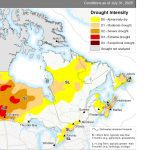ROSENORT, Man. – A quarter section on which Thorsten Stanze hopes to grow canola doesn’t look bad from the gravel road.The black soil is damp, with a little bit of trash on the surface, but ready to be seeded. Near the road is a thin strip of what looks like volunteer canola, but it’s the only canola he has left on this field.Stanze is one of the many farmers in Manitoba’s Red River Valley suffering from a massive rainfall that fell in the area during the last weekend of May.The rain, which also hit areas west of Winnipeg, flooded fields and killed crops.The trash on the rest of the quarter is the shrivelled remains of the canola crop that drowned in about 200 millimetres of rain water.“Heavy clay doesn’t take moisture,” said Stanze.He’s unsure what his next move will be, a common plight in this area.“There is a lot of stress around here,” said Stanze.Crop-only farmers are in a better situation than their mixed farm neighbours in the Red River Valley’s hog industry.Many farmers have been able to swallow three years of hog production losses with the gains made on crop production. This year, the crops could lose money also.Crop insurance covers massive rain and flooding like this, but the wrinkles of the program may mean farmers like Stanze get nothing.Stanze estimates about 50 percent of his crops are dead or severely damaged, but that’s the level at which crop insurance kicks in.Because he has crops spread across a wide area, he’s effectively “self-insured” against a total wipeout.Stanze thinks he’ll probably reseed dead canola fields to barley because it’s too late to plant canola.He also needs dry conditions to allow him to spray his surviving crops and some rain to moisten the crust of his soybean fields so the emerging crop can break through.For Stanze, it’s a terrible way to begin the summer, looking at crops that appear to have little potential.“It doesn’t really matter,” said Stanze. “What’s done is done.”
Read Also

Alberta eases water access for riparian restoration
Alberta government removes requirement for temporary diversion licence to water plants up to 100 cubic metres per day for smaller riparian restoration projects

















